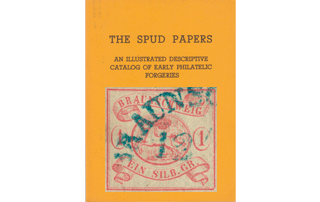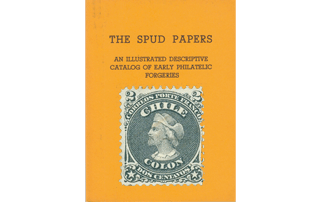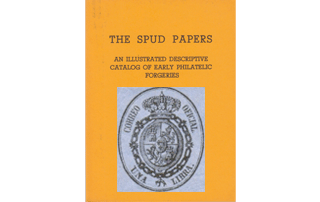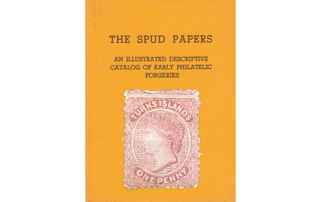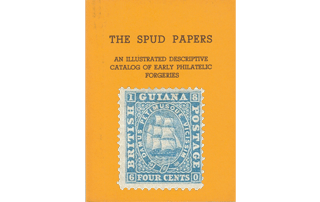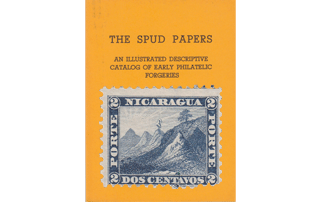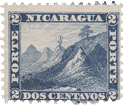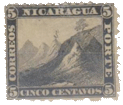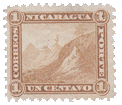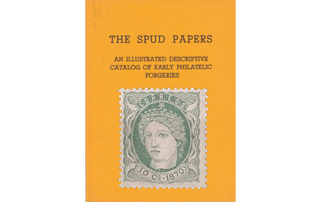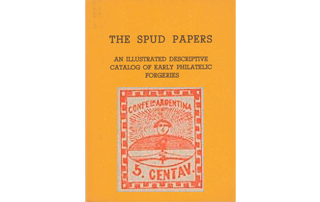


 1855. Official. Media, Una, Cuatro Onzas and Una Libra.
1855. Official. Media, Una, Cuatro Onzas and Una Libra.
The counterfeits we are about to describe are somewhat specious, particularly so from their being unobliterated, a very unusual thing for this sort of ware. One drawing did service for the originals, and the same course has been adopted for the shams.
Genuine
All the pearls or circlets in the crown are distinct, and can easily be counted. Between the topmost link of collar on the left and the crown, is quite a clear space. The first three letters of CORREO are close to the collar. Period after OFICIAL on a line with junction of links. Both the lions in shield crowned, and touching the lines above them. In the lower point of shield is a pomegranate.
Forged
Crown unevenly done, and ornaments not easily to be counted. Very little space between the crown and upper left-hand link of collar, CORREO at some distance from the
design. Period after OFICIAL below the level of the junction of links nearest to it. In shield, the upper lion is not crowned, and is too “scraggy;” the lower lion resembles a bear, and is also without a crown. The head of neither of the animals touch the lines above them. The point at the bottom of shield is quite plain. This is the easiest test.
1 Real, Blue. 1874. 16 Maravedis, Rose.
(Carlist Insurrection)
I have the pleasure of presenting to our readers this month the counterfeits of the blue and the rose stamps of His (would-be) Majesty, Don Carlos. The blue forgery is rather well done, but the rose is very poor. However, as the stamps are not particularly rare, I dare say most of our readers will be able to judge for themselves as to the goodness or badness of the imitations. As a rule, I think Messrs. Spiro succeed pretty well when they have only lithographs to deal with; and, if they would take the advice of one who does his best to pick holes in their productions, they would content themselves with imitating lithographs only; and let épargne and taille-douce alone. I always notice that when I can say a forgery is a pretty good imitation, the original is almost certain to be a lithograph.
1873. 1 Real, Blue.
Genuine
Lithographed, on thick, white, glace paper, no watermark, ungummed. The hair of the effigy is parted in the center of the fore- head. The point of the nose is shaded with dots. There is a good space of white between the eyebrows, and a faint white outline may be seen all round the beard, which is caused by the horizontal lines of shading in the background not being drawn quite up to the beard. The point where the neck is cut off in front is at some little distance from the edge of the containing oval. The horizontal lines of shading break off before they reach the edge on either side, so that there is a narrow rim of white all round the inside of the outline of the oval. The end of the moustache is long, and droops down, and then curls up again. (This requires to be closely examined, before it can be seen). The outline of the oval touches the frame at the middle of the left- hand side.
Forged
Lithographed, on thinnish, ordinary paper, ungummed. The hair is not parted at all. The point of the nose is not shaded. There are two little dots near the outer corner of the eyebrow; and if a vertical line be drawn down from those dots, it will almost pass through two larger dots, one on the upper edge of the whisker, and the other on the lower edge. None of these dots are found in the original. The eyebrows almost meet, there being but the very faintest separation between them. There is no white outline round the beard; and the beard itself is much more like a beard than in the genuine. The point of the neck in front is very near the edge of the containing oval. The horizontal lines of shading almost cut into the outline of the oval in front of the forehead and in front of the beard. The end of the moustache is quite short, and scarcely comes beyond the corner of the mouth. The outline of the oval does not touch the frame anywhere.
Postmarks
There is a great variety of postmarks in the genuine stamps. Out of eight stamps now before me, two are postmarked with the diamond of dots with a solid diamond in the centre, so familiar on the 1870 stamps; the third is simply pen-marked; the fourth is pen-marked, and has, in addition, a large circular date-stamp struck in blue, from VIZCAYA; the fifth is also pen-marked, and has a five-pointed star struck in blue; the sixth has this star without pen-mark; the seventh has a small circular date-stamp, struck in black, bearing ESPANA and part of the name of a town; the eighth has seven short parallel bars, forming a long rectangle, as long as the width of the stamps.
The forgeries are postmarked with a large rectangle of dots (square dots, not round like the genuine). This rectangle is almost exactly the size of the stamps.
1874. 16 Maravedis, Rose.
Genuine
Lithographed, on thin, slightly-surfaced paper, backed with a white gum. There is a tilde over the N of ANO and of CATALUNA. The stop after CORREOS is circular. The 1 of 16 comes both higher and lower than the 6, and the monetary denomination is MS VN. The hair behind the ears down to the back of the neck is cut quite short. The lines forming the network are wavy, and the meshes are therefore somewhat oval in shape. The lines of shading on the ends of the upper scroll are much thicker and somewhat shorter on the right side than on the left. The shading on the forehead is light. The moustache droops very little. The beard is easily distinguished from the shading on the neck. The whiskers join the hair. The outline of the frame is very jagged.
Forged
Liographed, on paper slightly stouter than that of the forged i real; ungummed. ANO and CATALUNA without accents. The stop after CORREOS is a short hyphen. The 6 of 16 is higher than the I, and the I is lower than the 6. The N of is merely a blotch; I suppose the forgers did not know what it was. All the hair is long, and looks marvelously like a wig. It seems all to spring from the back of the head. The lines forming the network are straight, and the
meshes are diamonds. The lines of shading on the upper scroll are very much longer on the right side than on the left. The front of the forehead is heavily shaded, and the neck is so absurdly dark in front that it looks like part of the beard. The whisker also appears to be pointed, from the same cause. There is a small division between the hair and the whisker. The moustache droops a good deal. There is a mark like a large comma just above the middle of the eyebrow, which is altogether absent in the genuine. The outline of the frame is well done.
Postmarks
I have not seen any postmarked specimens of the genuine stamps, but the forgeries are obliterated with a large rectangle of square dots, like the forged 1 Real.
Both forgeries are printed in sheets, of 25, 5 x 5. The colour of the rose stamp is a fair imitation of that of the genuine, though of a more chalky hue. The blue stamp is rather of a greenish cast, and is a more delicate colour than the genuine.
1874. 1/2 Real, Rose.
If Don Carlos really resembles the portraits on the two types of the 1/2 Real stamps, I don’t at all wonder that well-disposed Spaniards should resist his claims to their allegiance; for these portraits are simply hideous; and, as represented on these stamps, he would, for ugliness, be a fitting consort for Queen Isabella, as represented on the Philippines of 1854.
I don’t know which type is the earlier, but the one which I will call Type I. has the rays round the medallion very faint; the lines of shading behind the head very close together; the scrolls touch the framework both at top and bottom, and the portrait is that of a fat, bull-necked man. In Type II. the scrolls are narrower, and do not touch the framework; the rays are well defined; the lines of shading behind the head are faint and wide apart; the beard is longer, and the face is thinner. The one which the forgers have imitated is this latter stamp, which I have called Type II., and which I will now proceed to describe.
Genuine
Lithographed, on thinnish white wove paper, which shows very distinctly the texture of the canvas or wire-gauze on which it was formed. This paper is similar to that of the Brazilian stamps (Roman numerals), or to that of our own newspaper wrappers. In the portrait, the blank space on the under jaw, above where the beard grows, is of a pointed form, the point being above the figure of value. Behind the head there are 28 horizontal lines of shading, if counted down the right-hand side, and 30 if counted down the left-hand side of the head. There are 77 oblique rays round the medallion, and there are two of these rays between the point of each fleur-de-lis and the end of the scroll above it. If the little oblique line which divides the figures of the fraction 1/2 were continued upwards, it would pass considerably to the right of the face. I think these tests will be sufficient, though there are many other minute points of difference.
Forged
Lithographed, on rather stout ordinary white wove paper. The blank space on the under jaw, above where the beard grows, is semicircular. Behind the head there are 32 lines of shading, counted from the right, and 33 counted from the left. There are 88 oblique rays round the medallion. These rays, both in genuine and forged, must be counted from
the outside (i.e., where they touch the framework), for some of the rays only go from the outline of the oval to the outline of the scrolls. There is only one clear ray between the point of the fleur-de-lis on each side, and the end of the scroll above it. A continuation
of the oblique line in the fraction would cut through the beard, and touch the point of the nose. The colour of the genuine stamps is a pale rose, whilst that of the forgeries is a deep red, almost carmine. The genuine stamps are gummed; the forgeries are not.
1874. 1 Real, Lilac.
Genuine
Very well lithographed, on white wove paper, gummed. The nose is rather blunt, the tilde over the N of ESPANA is very distinct; the top of the F of FRANQUEO is below the level of the other letters; the shading behind the scrolls is composed of vertical wavy lines, fine, but distinct. The whole of the ear is lightly shaded, and there is a line or wrinkle from the corner of the nose to the corner of the mouth. The unshaded part of the neck runs up almost to the tip of the ear. This is a handsome stamp, and well printed; indeed, at first I thought it was engraved. Unfortunately, the forgers have-succeeded in producing a very creditable imitation, and our readers must content themselves with these few tests which I have been able to discover. All the more important details of the original have been very closely copied, line for line.
Forged
Lithographed, on yellowish-white paper, ungummed. The nose ends in a very sharp point; and the profile reminds me very much of that of the King of the Belgians on the current stamps. The tilde over the N of ESPANA looks more like a thickening of the outline of the scroll than anything else, and it does not stand out separate from the outline of the scroll as the genuine does. The top of the F of FRANQUEO is above the level of the other letters. The shading behind the scroll is partly solid, though some of the lines can be seen in the right top corner. However, these lines are straight. The rim of the ear is quite white, and there is no wrinkle or line on the face. There is a white dot on the under lip, and another on the side of the chin, below the corner of the moustache. These are not seen in the originals. The white, un- shaded part of the neck does not come near the ear; it only comes about as high as the level of the mouth.
Postmarks
I have not seen either of these stamps postmarked, but the forgeries are obliterated with a large rectangle of square dots.
Gum
The gum on the originals is perfectly white; the forgeries are ungummed. Both originals and forgeries are unperforated. If the reader will kindly compare this forged 1 Real with a genuine copy, he will see why I have found it so difficult to give good instant tests.
From “The Spud Papers” by Atless, Pemberton & Earée, 1871-1881.
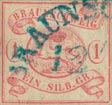
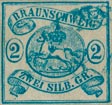
 1852. 1 S.GR. Rose, 2 S.GR. Blue and 3 S.GR. Vermilion – on White Paper.
1852. 1 S.GR. Rose, 2 S.GR. Blue and 3 S.GR. Vermilion – on White Paper.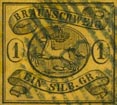
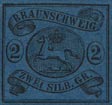 1 S.GR. Yellow, 2 S.GR. Blue and 3 S.GR. Rose – Coloured paper.
1 S.GR. Yellow, 2 S.GR. Blue and 3 S.GR. Rose – Coloured paper.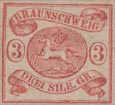 3 S.GR. Rose – White paper.
3 S.GR. Rose – White paper. 1865. 1 S.GR. Yellow – White paper.
1865. 1 S.GR. Yellow – White paper.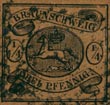 1/4 S.GR (Drei Pfennig).
1/4 S.GR (Drei Pfennig).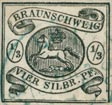 1/3 S.GR. (Vier Silbr. Pf).
1/3 S.GR. (Vier Silbr. Pf). 1/2 S.GR. (Fünf Pfennig)
1/2 S.GR. (Fünf Pfennig)![]() See also —> Album Weeds – Braunschweig (Brunswick)
See also —> Album Weeds – Braunschweig (Brunswick)
